Physical Address
304 North Cardinal St.
Dorchester Center, MA 02124
The most common sources of pain and dysfunction in the lower limb of an athlete are musculoskeletal in origin; however, vascular pathology may also present with similar symptoms. Sports that involve frequent repetitive joint motion or high-impact collisions have the highest incidence of symptoms or injury due to vascular pathology.
Vascular issues in athletic patients may be difficult to diagnose for several reasons. First, most athletes are young and otherwise in good health, making vascular disease an unlikely concern in the differential diagnosis. Second, an injured athlete's signs and symptoms may have other plausible musculoskeletal etiologies, which could present in an identical fashion. Provocative testing and appropriate imaging are therefore often required for the diagnosis of underlying vascular pathology. Third, a clinician may not be entirely familiar with the typical presentation of vascular pathology in the lower limbs, details of the vascular physical examination, and diagnostic criteria for vascular disease in the differential diagnosis.
Underlying vascular issues should be suspected in any athlete who presents with limb pain, early-onset fatigue, limb swelling, limb discoloration, or skin color changes. Familiarity with provocative physical examination maneuvers and imaging modalities is essential to confirm most vascular diagnoses. Moreover, simulation of an athlete's sport-specific positioning, motions, and level of exertion during vascular testing can uncover underlying pathology and can mean the difference between confirming or missing the diagnosis.
Vascular pathology that remains undetected for a prolonged period may have serious consequences for the athletic patient, including retirement, loss of limb function, or even limb amputation. Consequently it is important for the clinician to be familiar with the spectrum of traumatic and nontraumatic vascular knee injuries so as to facilitate early detection, diagnosis, and treatment and provide the athletic patient with a clear prognosis. The intent of this chapter is to review common vascular knee injuries in athletes and provide sports medicine practitioners with a reference for the presentation, evaluation, and clinical management of lower extremity sports-related vascular injuries, including a guide for return to sports when appropriate.
Tibiofemoral knee dislocation is a severe injury with the potential for limb-threatening vascular compromise. Although historically traumatic knee dislocations have been considered to be rare injuries, in recent years they have been reported more often. The popliteal vessels—which cross the popliteal fossa and are anchored above and below the joint by the adductor hiatus and the soleus muscle, respectively—are particularly vulnerable to injury from knee dislocation ( Fig. 109.1 ). Such dislocations are defined in terms of the tibial displacement with respect to the femur and can be characterized as anterior, posterior, lateral, and rotatory.
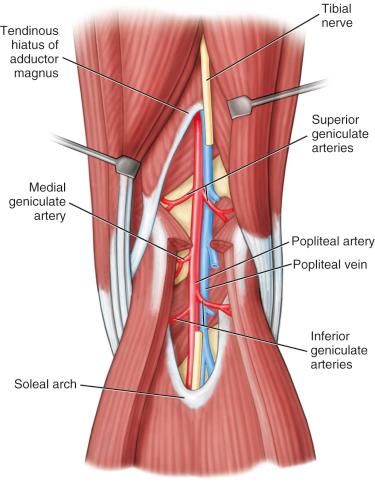
Anterior dislocations are the most common, constituting 50% to 60% of all knee dislocations. Forced hyperextension is the primary mechanism of injury causing anterior dislocation. In his 1963 landmark study, Kennedy reproduced anterior knee dislocations using cadaver knee specimens subjected to various degrees of hyperextension and found that the vascular trauma occurred during forced hyperextension. Rupture of the popliteal artery occurs at an average of 50 degrees of hyperextension. However, at angles below the threshold of arterial rupture, stretching that results in injuries to the tunica intima, contusion, laceration, transection, or avulsion of the popliteal vessels may still occur. Intimal tearing increases the likelihood of arterial occlusion and thrombosis. The poor collateral circulation surrounding the knee joint, as well as the soft tissue injury, further increases the risk for ischemia due to acute popliteal occlusion. Damage to the popliteal artery occurs in 40% of anterior knee dislocations. Moreover, stretching of the tibial nerve within the popliteal fossa may cause paresthesia in the lower leg, which is often a finding associated with knee dislocation and popliteal artery injury.
Posterior dislocation of the tibia on the femur accounts for approximately 33% of knee dislocations and may also be a source of potential neurovascular injury. Kennedy's hallmark study revealed that much greater forces are required to induce posterior knee dislocations compared with anterior knee dislocations, such as those that occur in the classic “dashboard car injury.”
Injury to collateral ligaments in association with damage to the posterior cruciate ligament (PCL) results in posterior dislocation and multidirectional instability that increases the likelihood of damage to the neurovascular structures within the popliteal fossa. Green and Allen reported that 44% of posterior dislocations had associated injury to the popliteal vessels. Posterior displacement of the tibia directly translates force onto the popliteal artery and vein, with a high likelihood of vessel transection.
When knee dislocation is diagnosed or suspected, one of the primary jobs of the clinician is to determine if concomitant injury to the popliteal artery and/or vein has occurred. Failure to recognize popliteal artery injury and restore vessel continuity after knee trauma is a potential cause of lower extremity amputation. Consequently early recognition of vascular injury remains paramount for limb salvage. During a knee dislocation, the popliteal vessels are at risk for injury because of their anatomic location (see Fig. 109.1 ). The superficial femoral artery traverses the tendinous hiatus of the adductor magnus muscle and continues as the popliteal artery. Small collateral vessels branch off of the popliteal artery as it crosses the knee joint within the popliteal fossa; these are the medial and lateral superior geniculate, middle geniculate, and medial and lateral inferior geniculate arteries. The popliteal artery exits the popliteal fossa anchored below the knee joint by the soleal arch before dividing into the anterior and posterior tibial arteries. The genicular arteries form an intricate network of collateral vessels surrounding the contiguous ends of the femur and tibia. This circumpatellar network is divided into superficial and deep plexuses. The superficial plexus is located between the fascia and skin and forms three well-defined arches, one above the upper border of the patella and two below the patella. The deep plexus forms a close network of vessels that surround the articular surfaces of the femur and tibia. The network of genicular anastomoses provides the leg with collateral circulation, which is abundant in number but small in vessel caliber; frequently the collateral vessels are injured or disrupted in conjunction with the popliteal artery during knee dislocation as a result of soft tissue injury.
The anterior and posterior tibial veins converge to form the popliteal vein at the lower border of the popliteus muscle. Occasionally the popliteal vein is duplicated and present on both the medial and lateral aspects of the popliteal artery. Proximal to the popliteal fossa, the popliteal vein traverses the adductor hiatus and continues as the femoral vein.
Injury to the popliteal artery has been reported to occur in approximately 30% of all complete knee dislocations. Types of arterial damage sustained during dislocations of the knee may include injury to the tunica intima, avulsion injury, occlusions, aneurysm generation with secondary thrombosis, embolization, rupture, and transection. Although trauma to the popliteal vessels is easily detected in cases of open knee injuries, identification of neurovascular injury as a result of blunt knee dislocation or instability may be delayed or missed entirely. Clinical indicators of vascular trauma after knee dislocation are classified as hard or soft signs ( Table 109.1 ). Hard signs demand immediate vascular repair and include pulse deficits, acute limb ischemia, active hemorrhage, and pulsatile hematoma. Hallmark signs of acute limb ischemia include pain, paresthesia, loss of sensation or motor function, pallor, and pulselessness in the distal extremity of the affected limb. In the presence of these hard signs, a diagnosis of vascular injury is strongly suggested, and treatment should involve immediate vascular repair. Alternatively, soft signs of injury to the popliteal artery after knee dislocation warrant further diagnostic evaluation and monitoring. These signs include small hematomas, reduced pedal pulses and ankle pressures, neural deficits from injury to the tibial nerve or its branches, and early hemorrhaging that has ceased. When soft signs are present, imaging of the popliteal vessels is required to assess the extent of vascular trauma.
| Type of Sign | Indicator |
|---|---|
| Hard | Pulse deficits in pedal pulses with an ankle brachial index <0.5 |
| Distal ischemia (pain, paresthesia, pallor, and other symptoms of acute ischemia) | |
| Active hemorrhage and pulsatile bleeding | |
| Expanding hematoma | |
| Evidence of compartment syndrome | |
| Soft | Small hematoma that does not change in size |
| Hemorrhage that has ceased | |
| Reduced ankle pressure <0.9 but >0.5 | |
| Neural deficits from injury to the tibial nerve |
Vascular injuries associated with knee dislocations result from excessive stretching or transection of the popliteal vessels ( Fig. 109.2 ). Common vascular injuries following anterior knee dislocations include intimal tears and the formation of intimal flaps. In such patients, blood flow through the artery may not be appreciably altered; consequently patients may present without any hard signs of vascular trauma. Nevertheless, the presence of intimal tears and flaps increases the risk of thrombosis and embolization. Moreover, extensive intimal injuries accelerate vessel wall damage over time, and patients who initially lack symptoms of vascular compromise may begin to exhibit diminished popliteal flow. Some authors suggest that posterior knee dislocations more commonly result in transection of the popliteal artery, with resultant acute limb ischemia. Blood flow through the popliteal artery becomes significantly diminished ( Fig. 109.3 ), and patients present with immediate hard signs of vascular injury such as active hemorrhage, expanding hematoma, bruits in the distal arterial circuitry, and signs of acute ischemia such as pain, paresthesia, poikilothermia, pallor, and pulselessness. These signs indicate significant vascular compromise that demands immediate operative intervention and vascular repair.
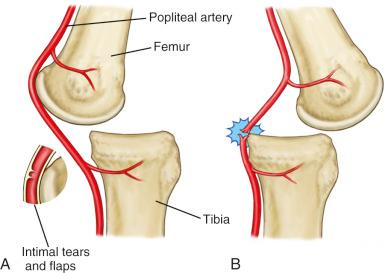
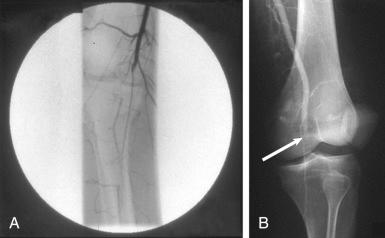
The high rate of popliteal artery injury associated with knee dislocations, combined with the possibility of delayed presentation of symptoms of vascular trauma as a result of knee dislocation, demands that diagnostic evaluation for vascular integrity be performed for all patients suspected of having a knee dislocation. The diagnosis of knee dislocation itself is based on the mechanism of injury obtained from the history, physical examination, and radiographic findings. Frequently patients may present with the knee already reduced. Because the risk for arterial injury is the same in both the reduced and dislocated knee, clinical suspicion of popliteal artery damage should remain high in such patients. Absence of hemarthrosis in patients suspected of having had a knee dislocation does not decrease the risk for vascular injury.
Diagnostic evaluation of vascular integrity in the lower limb is critical to determining a method of treatment ( Fig. 109.4 ). Serial measurements of pulse quality in both the posterior tibial and dorsalis pedis arteries should be performed because the pulse may be diminished or absent after an upstream arterial injury. Studies reveal that clinical evaluation of peripheral pulses accurately identifies the existence of vascular lesions after knee dislocation with a specificity of 91%. Although the presence of pulse abnormalities is sufficient to rule in the existence of vascular lesions, a low sensitivity of 79% means that vascular injury may exist in the absence of peripheral pulse deficits. In addition to digital pulse evaluation, serial measurements of the ankle-brachial index (ABI) enable the clinician to qualitatively assess deficits in distal perfusion induced by vascular trauma. ABI values less than 0.9 indicate the presence of vascular injury requiring surgical intervention with 95% to 100% sensitivity and 80% to 100% specificity.
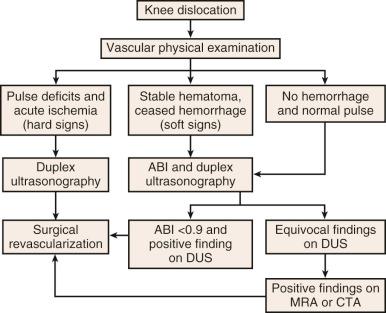
In patients presenting with pulse abnormalities and associated ischemia, surgical intervention and revascularization is the primary priority, and imaging may be performed to determine the location and severity of vascular compromise. In this context, imaging aids in determining the surgical approach and should be performed in the operating room to minimize warm ischemia time. Previous studies have found that approximately 3 hours are saved when arteriographic imaging is performed in the operating arena. In patients with pulse abnormalities in the absence of ischemia, imaging is mandatory to determine if intervention and vascular repair are required.
Historically arteriography has served as the gold standard for symptomatic vascular lesions after knee dislocation. This form of imaging allows the examiner to identify the location and extent of injury and the presence of intimal flap tears within both the popliteal artery and its distal branches. However, the invasive nature of angiography has led to a trend in recent years toward less invasive and safer imaging modalities. Moreover, arteriography is not fully reliable as an imaging tool. Studies have reported 1% to 6% false-negative rates, which can delay patient treatment, and 2.4% to 7% false-positive rates, which can result in unnecessary surgical intervention. In the Lower Extremity Assessment Project study, it was reported that patients with hard signs of vascular injury can be treated effectively without arteriographic imaging before surgery.
In recent years, duplex ultrasonography has become a mainstay of the rapid evaluation of vascular pathology resulting from suspected popliteal artery injury; duplex ultrasound can be used to analyze flow through the popliteal vessels in real time in the emergency department or operating room (see Fig. 109.4 ). Studies assessing the diagnostic value of duplex scanning as a means of noninvasive imaging in persons with lower limb trauma have reported a diagnostic sensitivity of 95%, a specificity of 99%, and a diagnostic accuracy of 98%. The rapidity with which duplex scanning can be performed makes it an ideal tool for the visualization of vascular trauma, particularly in patients with vascular compromise who are awaiting operative intervention.
Computed tomographic angiography (CTA) and magnetic resonance angiography (MRA) can also be used to visualize intimal tears when duplex ultrasound results are equivocal. Some recent studies challenge the usefulness of CTA imaging in patients with lower extremity vascular injury. For these patients, the presence of hard signs has a 100% predictive value for the identification of vascular injury, which reduces the need for CTA evaluation.
Warm ischemia time remains the single most important variable determining functional outcome in patients with a popliteal artery injury resulting from knee dislocation. Prompt diagnostic evaluation, including imaging to determine the extent of vascular injury, and operative intervention to restore adequate distal perfusion in the hypoperfused patient are essential for successful treatment and limb salvage. Warm ischemia times greater than 6 hours can cause irreversible neurologic injury and muscle necrosis distal to the site of blood flow obstruction, and the rate of amputation in patients who experience a delay in arterial reconstruction exceeding 8 hours has been reported to be 85%. Consequently any delay of imaging and immediate intervention in cases of limb ischemia increases morbidity and worsens patient prognosis.
Immediate surgical repair is obligatory as soon as vascular trauma is confirmed. The principles of surgical intervention in patients with popliteal artery injuries include (1) rapid restoration of arterial blood flow to the distal extremity, (2) removal of thrombus in the distal artery, and (3) alleviation of acute compartment syndrome, which may exacerbate distal ischemia. Whether vascular or orthopaedic reconstruction should be performed first remains an area of debate, with the appropriate sequence of repair depending on the time course of injury and the severity of the ischemia. If the patient presents with prolonged warm ischemia time or severe deficits in distal perfusion, prompt vascular repair and restoration of arterial flow is indicated before orthopedic management. In such cases, however, secondary orthopedic procedures may damage newly repaired vascular structures. Consequently the order of repair should be determined on a case-by-case basis, with special consideration given to the extent and severity of ischemia in the presenting patient.
Reconstruction of the popliteal artery can be achieved through either posterior or medial approaches. The posterior approach allows for greater visualization of structures within the popliteal fossa and is more ideally suited for the treatment of lesions of the midpopliteal artery, whereas the medial approach allows easier access to distal structures of the popliteal fossa. The type of surgical repair performed depends on the extent of vascular injury and may include lateral repair of the artery, end-to-end arterial repair with interposition vein graft, repair of intimal injury by vein patch, or bypass by saphenous vein grafting. The majority of popliteal artery repairs that result from knee dislocations require venous grafting. Venous patches are used to provide structural integrity in cases of intimal tears and flaps, and greater saphenous vein grafts from the contralateral leg are used for extensive arterial resection. End-to-end repair of the popliteal artery through a posterior approach requires the least dissection of the popliteal artery and surrounding soft tissue. If the popliteal vein is also damaged after knee dislocation, venous repair is required; this can be accomplished by lateral repair or interposition vein grafts. Failure to repair venous injuries is associated with an increased risk of lower extremity edema, thrombosis, and embolization as well as limb loss. If ischemia has been present for more than 2 hours, a fasciotomy is mandatory to prevent compartment syndrome. Fasciotomy is required in the treatment of 50% to 80% of patients with injury to the popliteal artery and is associated with a significant improvement in the rate of limb salvage. Primary amputation is rarely indicated and is used only when extensive muscle necrosis is present in the distal extremity. Typically warm ischemia times exceeding 6 hours are associated with a dramatic increase in the rate of eventual limb amputation.
Although historically all popliteal artery injuries resulting from knee dislocations have been repaired through open surgical methods, endovascular techniques have become an increasingly popular form of treatment for blunt popliteal artery injuries and acutely ischemic distal lower extremities. Endovascular repair is a minimally invasive alternative to open surgery and is associated with a more rapid recovery time and decreased pain. Proponents of endovascular repair in cases of blunt popliteal artery injury cite the usefulness of a percutaneous approach in cases where extensive soft tissue damage to the surrounding structures of the popliteal fossa may complicate open repair. In addition, through endovascular repair, hemostasis can be achieved in locations where distal and proximal control is difficult to obtain. Furthermore, endovascular techniques allow for the visualization of the injury site, removal of any associated thrombus, protection against distal embolization, and repair of an intimal lesion. Authors have reported that there are no significant differences regarding early patient outcomes between endovascular and open repair in the management of traumatic lower extremity arterial injuries. However, the primary criticism of endovascular repair in patients sustaining traumatic injuries originates from concerns regarding technical success. Rates of complication after embolization of injured peripheral vessels, stent grafting, or both range from 0% to 25%; the authors presume that this large range is indicative of the discrepancies in endovascular procedures performed in different institutions.
More recently, the use of hybrid approaches, which combines the benefits of open vascular surgery and endovascular interventions, has become increasingly prevalent. Recent estimates suggest that 19% to 22% of revascularization procedures are done as hybrid procedures. Hybrid procedures are associated with improved limb salvage and decreased length of hospitalization; their primary and secondary patency rates are comparable to those of the open procedures.
Initial examination.
Patient history and physical examination are completed.
Pedal pulses on both the affected and contralateral limb are examined.
Bilateral ankle brachial indexes are measured.
The popliteal space is imaged using duplex ultrasonography.
In patients presenting with hard signs of vascular injury, no further imaging is required and immediate surgical intervention is warranted.
In patients presenting with soft signs of vascular injury or if the duplex scanning yields equivocal results, further imaging via magnetic resonance angiography and computed tomographic angiography is necessary to establish treatment protocol.
Open surgical intervention.
With the patient lying prone, an S -shaped incision is made in the popliteal region.
The posterior approach is preferred over the medial approach because it facilitates greater access to the neurovascular structures of the popliteal fossa with the least amount of soft tissue dissection and sparing of the saphenous vein.
Skin flaps are raised to expose underlying deep fascia, which is then transected longitudinally.
Care should be taken to avoid transection of the median cutaneous sural nerve.
The tibial nerve is encountered first and mobilized.
The popliteal vein passes through the medial and lateral heads of the gastrocnemius muscle deep in the popliteal fossa.
The popliteal artery lies deeper in the popliteal space and can be followed distally.
Arterial reconstruction is required if evidence of significant intimal injury, stenosis, occlusion, thrombosis, or laceration is observed.
A short interposition vein graft is placed; it is usually harvested from the ipsilateral lesser saphenous vein or contralateral saphenous vein.
An alternative is a short venous bypass graft with exclusion of the occluded artery to avoid thromboembolism.
Postoperative follow-up should include focused physical examinations with special attention to distal perfusion. Ankle pressures, ABI measurements, and duplex scanning should be performed to assess blood flow through the reconstructed artery within the popliteal fossa. Use of other imaging modalities such as CT/CTA and MRA are generally not recommended unless symptoms of graft occlusion or diminished blood flow reappear. Follow-up should be scheduled within 4 to 6 weeks after surgery and twice annually within the first year. In subsequent years, annual follow-up is recommended to ensure graft patency.
Postoperative complications after popliteal artery repair are centered on evaluation for delayed compartment syndrome, graft patency, maintenance of tension-free healing, and prevention of postsurgical deep venous thrombosis (DVT). Antiplatelet medications are typically prescribed for patients to prevent postsurgical graft thrombosis. Patency of the vein graft may be compromised by stenosis at the sites of venous graft-artery interface. Postsurgical follow-up should include physical examination and imaging via duplex ultrasonography to ensure graft patency and appropriate healing.
Popliteal artery entrapment syndrome (PAES) is characterized by the extrinsic compression of the popliteal vessels by the musculotendinous structures of the popliteal fossa. Anomalies in the embryologic development and migration of the medial head of the gastrocnemius muscle generate anatomic variants that entrap the popliteal vessels and tibial nerve. PAES is usually a congenital abnormality, with estimates of its frequency reported between 0.62% and 3.5% of the population, but functional PAES may occur in the absence of any embryologic or anatomic abnormality. In persons with functional PAES, the popliteal vessels become impinged from physiologic hypertrophy of the gastrocnemius, soleus, plantaris, or semimembranosus muscles. Functional PAES is particularly prevalent in well-conditioned athletes.
Entrapment of the popliteal artery was first documented by 1879 by Anderson Stuart, an Edinburgh medical student, who described an abnormality in the course of the popliteal artery in the amputated limb of a patient with gangrene. Nearly 50 years later, Louis Dubreuil-Chambardel described separation of the popliteal vessels by an accessory gastrocnemius muscle in a patient. Although entrapment of the popliteal artery has been documented for more than a century, it was not until the mid-1960s that the term popliteal artery entrapment syndrome was first used by Love and Whelan to define a clinical presentation. In 1985, Rignault et al. presented the first case report of functional entrapment syndrome caused by hypertrophy of the gastrocnemius in an “intensively trained athlete.”
After these initial reports, numerous publications documented the clinical progression of PAES in further detail. Studies have estimated that approximately 60% of young patients who present with intermittent claudication have PAES.
Originally Insua et al. presented the first classification system for PAES based on variations of the course of the popliteal artery in relation to the medial head of the gastrocnemius muscle. A simplified classification scheme for PAES, provided by Delaney and Gonzalez, was proposed and consisted of four subtypes. Modifications to the Delaney scheme by Rich et al. in 1979 yielded a five-subtype system that included impingement of both the popliteal artery and vein ( Fig. 109.5 ). Last, with the documentation of functional PAES by Rignault and colleagues in 1985, a sixth subtype was added to facilitate the classification of patients presenting with symptoms of PAES in the absence of any overt anatomic variation or developmental abnormality. The current six-subtype classification system is the most widely accepted system among clinicians.
Type I: Type I is the most common variant of PAES and is characterized by a significant medial shift of the popliteal artery with normal positioning of the medial head of the gastrocnemius muscle. This type of arterial entrapment occurs when the popliteal artery completes its development before the embryologic migration of the medial head of the gastrocnemius muscle. Consequently, as the medial muscle head completes its migration, it sweeps the popliteal artery medially.
Type II: In type II popliteal artery entrapment, the popliteal artery is shifted medially to a lesser degree than its type I counterpart, and the medial head of the gastrocnemius expresses variable attachment to either the lateral aspect of the medial femoral condyle, the intercondylar area, or the lower femur superior to the condyle. Type II entrapment occurs when the distal popliteal artery forms prematurely and temporarily arrests the migration of the medial head of the gastrocnemius. Consequently the popliteal artery is medially displaced relative to an abnormally positioned medial head of the gastrocnemius.
Type III: Type III popliteal entrapment results from abnormal mature muscle slips or fibrotendinous bands that branch off the medial head of the gastrocnemius muscle, slip between the popliteal artery and vein, and attach to either the medial or lateral femoral condyle. These accessory tissues are derived from the embryologic remnants of the migrating medial head; in the adult, they persist posterior to the popliteal artery. As a result, the popliteal artery becomes separated from the popliteal vein and entrapped between the two layers of musculotendinous tissue.
Type IV: Type IV popliteal entrapment occurs when the axial artery, the embryologic precursor of the tibial arteries, persists as the mature distal popliteal artery. Consequently the artery remains in its embryologic position and is compressed as it passes deep to the popliteus muscle or associated fibrous bands.
Type V: Type V popliteal entrapment can occur via any of the aforementioned mechanisms but is unique in that both the popliteal artery and vein are entrapped and compressed. Impingement of both popliteal vessels is estimated to occur in 10% to 15% of all cases of popliteal entrapment.
Type VI: Functional popliteal entrapment occurs in patients in the absence of any anatomic or developmental abnormality. Although the exact mechanism of popliteal entrapment in this subtype remains to be elucidated, it is believed that hypertrophy of the medial head of the gastrocnemius compresses the posteromedial aspect of the popliteal artery, resulting in physiologic occlusion of the artery during plantarflexion or extension. Some investigators have proposed that a more lateral attachment of the medial head of the gastrocnemius within physiologic normal limits may predispose a person to functional popliteal entrapment upon hypertrophy of the gastrocnemius as a result of lower limb exercise.
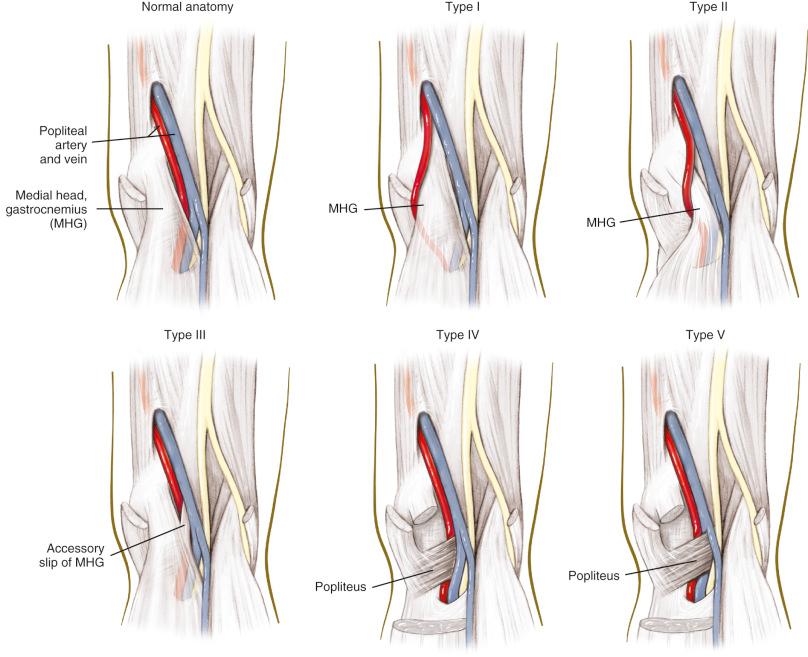
The hallmark of PAES is a young, active, and otherwise healthy person with intermittent claudication of the calf and foot. Approximately 60% of patients with symptoms of PAES are younger than 30 years, and the syndrome has a significant predilection for the male sex, with approximately 80% of all reported cases occurring in men. In more than a fourth of all cases, PAES is simultaneously present in both lower extremities. Participation in sports such as basketball, football, rugby, and martial arts is most commonly associated with popliteal entrapment.
Intermittent claudication of the calf or foot is the most common symptom and is reported to occur in 69% to 90% of patients with PAES. In rare cases, symptoms may present in an atypical fashion, such as the onset of claudication after standing or walking, which improves with running.
In addition to claudication, patients may present with symptoms such as coldness, pallor, or loss of sensation in the lower extremities. Because the tibial nerve travels adjacent to the popliteal artery through the popliteal fossa, all cases of PAES may potentially impinge the nerve and result in paresthesia in the distal extremity. In fewer than 10% of patients with PAES, concomitant symptoms of critical limb ischemia (CLI) may exist. Signs and symptoms of CLI include paresthesia, pallor of the foot and toes, ischemia, pain upon resting, and tissue necrosis. Importantly, PAES results from the extrinsic compression of the popliteal artery rather than intrinsic occlusion from atherosclerosis, as observed in patients with peripheral arterial disease. Consequently the patient with PAES who has signs and symptoms of CLI will lack the diffuse atherosclerosis observed in patients with end-stage peripheral arterial disease. Acute limb ischemia is rare in patients with PAES. A patient with PAES who has venous involvement may also report calf and ankle swelling.
In most cases, pedal pulses are palpable and normal at rest in a patient with PAES provided that compression of the popliteal artery has not progressed to a state of chronic occlusion. Blood flow through the lumen of the popliteal artery is significantly attenuated upon compression. Stress maneuvers such as active plantarflexion or dorsiflexion of the foot against resistance temporarily stenoses the otherwise patent lumen of the popliteal artery in the patient with PAES and results in diminished pedal pulses. Left untreated, the constant compressive stimuli may compromise the structural integrity of the popliteal artery and cause chronic occlusion.
In approximately 12% of cases, poststenotic dilatation of the popliteal artery may occur after compression. In such patients, degeneration of the popliteal artery increases the likelihood of aneurysm formation; popliteal aneurysms in these otherwise young and healthy persons can be a source of distal embolization. Studies report that between 20% and 30% of patients with popliteal artery aneurysm in conjunction with PAES experience an embolic event in the absence of intervention. Alternatively, distal emboli may also result from focal thrombus formation secondary to arterial degeneration in a normal-caliber entrapped artery.
Become a Clinical Tree membership for Full access and enjoy Unlimited articles
If you are a member. Log in here